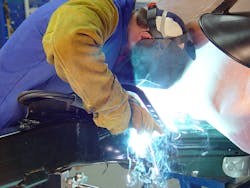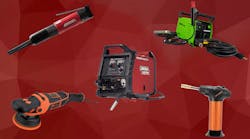Selling tools and equipment to body shops can prove challenging to some distributors. These specialty shops complete a different line of work on the vehicle, involving the structure and frame, versus the mechanical operation, of a vehicle.
Of late, aluminum bodies have become a hot topic to the industry. While new tool technologies can take a few years to show up in general automotive aftermarket repair shops, body shops will utilize these aluminum repair tools much sooner.
Director of collision in North and South America for Vehicle Service Group (VSG) Bob Holland says collision repair licensing requirements vary by state, and regional and local regulations also may apply.
“Insurance companies may decline to work with an unlicensed shop, so be sure to learn what regulations exist in your region before selecting a facility,” says Holland, whose company VSG (www.vsgdover.com) is comprised of nine vehicle lifting and collision brands, including Chief Automotive Technology (www.chiefautomotive.com).
The right body shop tools
Chief Automotive Technology officials note that a body shop with quality technicians, a productive shop with solid work processes, an accurate estimating process and a great reputation can fail if the facility is not equipped with the proper tools and equipment.
There are three pieces of equipment that serve as the foundation of any body shop and are must-haves to properly service vehicles, VSG’s Holland says. They are a measuring system, spot welder and frame rack, and none should be outdated.
Measurement systems
The measuring system is used to determine which areas of the vehicle are out of position after a collision, Chief officials explain. This is important because damage is rarely limited to the point of impact as many modern vehicles are designed to transfer collision forces around the passenger compartment.
“A system that measures the entire vehicle, like Chief’s LaserLock Live Mapping system, ensures that no hidden damage will go unnoticed,” VSG’s Holland says. “An advanced measuring system will also enable a shop to provide you with a comprehensive pre-repair estimate for better planning purposes.”
Spot welders
To ensure a vehicle is returned to OEM specs properly, Chief officials say an OEM-approved spot welder must be used. Spot welders that feature automatic modes can speed up the repair process or make up for a technician’s lack of skills.
Frame racks
A frame rack’s capabilities play a big role in determining if a shop can accept a job or if the work has to be turned down. Because not all frame racks are built to handle the same vehicles, make sure a shop is equipped with a rack that has enough capacity to lift the vehicles in need of repair, VSG’s Holland says.
Other tools
Other tools that successful body shops have access to include:
- Aluminum welders.
- Aluminum workstations.
- Multi-point pulling equipment.
- Structural holding equipment.
- Fume extractors.
- Rivet guns.
- Slide hammers.
- Hammers and dollies.
- OEM-specific tools.
- MIG welders.
- Plasma cutters.
- Dent pullers.
- Organizing systems.
Aluminum structural repairs
When it comes to repairing aluminum, the lightweight metal is no more demanding than working with steel, it’s just different,” says Geoff Preston of Dent Fix Equipment (www.dentfix888.com) – a manufacturer and importer of the body shop equipment.
Aluminum behaves differently than steel, adds Adam Smith of BTB Auto Glass and Body Shop Tools (www.btbtools.com) – a manufacturer of tools for the auto glass replacement, collision repair and other industries. “Steel has a memory. It will tend to want to go back to where it was, whereas aluminum doesn’t.”
Ford F-150
Aluminum body work has become more prevalent since Ford released its aluminum-bodied 2015 F-150. Aluminum body work was performed prior to the 2015 F-150’s release, but only on certain high-end vehicles and specific hoods and tailgates.
"Judging by the overall success of Ford’s efforts to prepare the repair industry and the high F-150 truck sales, it is very likely more vehicles in the industry will follow the F-150’s transition,” Dent Fix’s Preston says, noting more and more manufacturers are following Ford by utilizing aluminum panels in production vehicles.
Working on aluminum “is becoming a must,” BTB’s Smith agrees. “It was a bit of a ‘Should we? Should we not?’ I don’t think that’s a choice anymore.”
According to Dent Fix’s Preston, manufacturers are shedding the perception that aluminum panels are weak like soda cans. “The relatively thin aluminum panels have a surprising amount of rigidity and resistance to dents.”
Shop investment
The biggest challenge faced by body shop technicians is making the initial investment in the proper equipment to perform aluminum body service.
“Jaguar and Aston Martin and those sorts of companies have been using aluminum for quite a number of years,” BTB’s Smith explains. “But your average body shop might not see too many Jags or BMWs or Aston Martins, so they didn’t have to worry about equipment. Now that your most-sold vehicle in the country has aluminum on it, they’re going to have to tool up or potentially lose business.”
“The first thing to consider when purchasing aluminum tools is contamination,” Dent Fix’s Preston says. “Most shops have steel and aluminum work happening in a shared space. This means there are air-borne steel contaminates that could contaminate the aluminum panel through a process called galvanic corrosion."
“To avoid this, most car manufacturers require their authorized shops install an aluminum dust collecting system and fume extraction,” he continues. “They usually also recommend an aluminum-dedicated work room or area with a special curtain.”
Tools
Additionally, cross-contamination can occur if tools are used on steel and then aluminum.
“To prevent this, aluminum-specific tools must be purchased,” Preston says. “They usually have a red mark to indicate aluminum-only use.”
Most of the commonly used aluminum repair tools are related to pulling dents. Aluminum-specific body shop tools, which are contained in Dent Fix’s Aluspot Aluminum Repair Station, include:
- Inline pneumatic paint remover with stainless steel brush, stainless steel shoe handle and tooth brush.
- Digital set temperature heat gun and infrared temperature gauge.
- Capacitor discharge welder with a self-contained weld gun with ground.
- Alu-magnesium stud pins and Alu-silicon stud pins.
- Hand T-puller, squeeze puller, lever puller and bridge puller.
- Body file with 340mm blade and stud cutter.
- Pick/finishing hammer, curved pein/finishing hammer, reverse-curve hammer, 22mm soft face hammer and 35mm dead blow hammer.
- Bolster-head nylon chisel, round-head nylon chisel, double-end nylon dolly, utility dolly, double-end dolly, thin-toe dolly, heel dolly and curved dolly.
- Dust cover.
Additionally, BTB’s Smith suggests having the following tools for aluminum work:
- Proper glass removal tools.
- Self-piercing rivet (SPR) gun.
- Frame adapters for holding and measuring aluminum.
Dent Fix’s Preston adds there are health and safety concerns regarding aluminum and steel dust particles, so protective eyewear is encouraged. The need for aluminum-specific tools will continue to increase as aluminum bodies gain popularity.
“It’s coming sooner than most people think,” Preston says. “It has long been a desired building material for the super car world for its lightweight properties, which increase performance numbers ... As manufacturing costs go down, aluminum panels should become the go-to source for manufacturers looking to drop weight.”
Differences in aluminum and steel body repair processes
Despite the differences between the two metals, the basic body shop repair concepts are the same, Dent Fix's Preston notes. These include:
- Always expose the bare aluminum.
- Remove OEM paint.
- Remove oxidation, which can form quickly when aluminum is exposed to oxygen. That oxidation affects welding joint.
- Heat the panel to the manufacturer’s recommended heat range when pulling dents.
- Take into consideration the thinner and different nature compared to steel panels.
- Hammer-on and hammer-off dolly techniques, when used properly, are both effective.
- Hammer-off dolling with heavier, highly polished steel hammers and heavier dollies should be used on high spots and severe impact sections. However, aluminum can stretch too thin beyond repair so caution should be exercised.
- Hammer-on dolling is used by experienced technicians with lightweight aluminum hammers and POM nylon dollies.
- Aluminum panels with creases are mostly replaced.
- Work hardening occurs when the metal is worked. Work the metal too much, and it can break – similar to bending a spoon.


